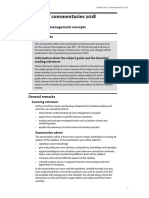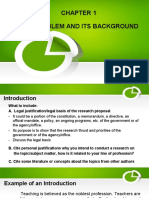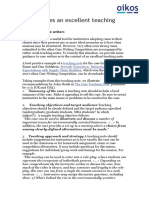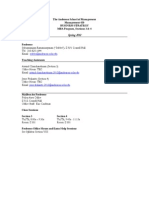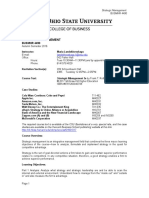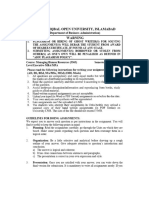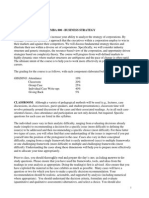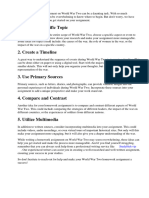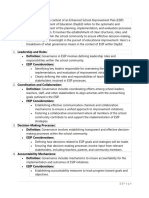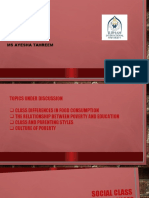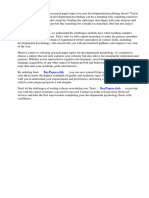Emerging Markets Case Studies (ISSN: 2045-0621) Guide To Writing A Teaching Note Purpose of A Teaching Note
Emerging Markets Case Studies (ISSN: 2045-0621) Guide To Writing A Teaching Note Purpose of A Teaching Note
Uploaded by
Fildzah FichanCopyright:
Available Formats
Emerging Markets Case Studies (ISSN: 2045-0621) Guide To Writing A Teaching Note Purpose of A Teaching Note
Emerging Markets Case Studies (ISSN: 2045-0621) Guide To Writing A Teaching Note Purpose of A Teaching Note
Uploaded by
Fildzah FichanOriginal Description:
Original Title
Copyright
Available Formats
Share this document
Did you find this document useful?
Is this content inappropriate?
Copyright:
Available Formats
Emerging Markets Case Studies (ISSN: 2045-0621) Guide To Writing A Teaching Note Purpose of A Teaching Note
Emerging Markets Case Studies (ISSN: 2045-0621) Guide To Writing A Teaching Note Purpose of A Teaching Note
Uploaded by
Fildzah FichanCopyright:
Available Formats
Emerging Markets Case Studies (ISSN: 2045-0621)
Guide to writing a Teaching Note
Purpose of a teaching note
A teaching note acts as a guide to both instructors who are deciding whether to teach your case
and to those who have decided to teach your case. It shows the teaching objectives of the case as
well as the academic value an instructor adds to the information in the case through the teaching
process. It gives the instructors resources they could use to deepen their knowledge of the topic
being taught. It also demonstrates your depth of knowledge of the chosen field of academia.
Many of the emerging market cases will be taught by instructors who have never lived, worked
or taught in the specific emerging market setting of your case study, and so your teaching note
should enable the instructors to gain insights into the complexities and challenges of these unique
operating environments.
A teaching note also gives suggestions as to how the case could be taught; from the questions the
students should prepare before the class based on their reading of the case, to an example of a
plan for the case teaching session. It includes possible answers to the assignment questions and
may include a range of additional materials that could be used by the lecturers. It does not
prescribe how a case should be taught, it merely offers suggestions. A teaching note can be of
great assistance to instructors who are new to teaching cases, so it should reflect knowledge of
case teaching methodology. The teaching note is not shown to the organization or person about
whom you wrote the case or to the students.
Method of writing a teaching note
A teaching note should be begun at the same time as the outset of writing the case and should
evolve over a period of time. The teaching objectives and major theoretical aspects should be
decided on before the case is written as discussed in the guidelines for writing a case. The
analysis of the assignment questions could be written before you teach the case for the first time.
The teaching plan section may only be written after you have taught the case for the first time
and you discovered what worked and didn’t work in the teaching process. You would also then
be aware of what issues the students raised that you may want to discuss in the teaching note.
Teaching notes require a great detail of preparation as they become part of the intellectual capital
of the teaching fraternity and become part of your academic brand.
Format of a teaching note
It is strongly suggested that submitted teaching notes follow the format and all the headings
given in the template example below. It is expected that a teaching note would be a minimum of
4000 words but may go up to 10,000 words.
Prepared by Dr. Margaret Sutherland 1 Updated: October 2015
and Dr. Michael M. Goldman
Teaching Note
THE NAME OF THE CASE STUDY IS PLACED HERE
SYNOPSIS
This should be a 150-200 words synopsis of the case study. In it you should give a few details of
the name of the organisation, the industry, the country, the time span of the case study, the
protagonist and what the challenge facing the protagonist is. You should give a sense of what
sub-field of academia the case is designed to teach e.g. market segmentation in the
telecommunications sector, or performance management in the NGO sector.
TEACHING OBJECTIVES
This section should be between 150 and 250 words long. It should state the level of student the
case is aimed at e.g. undergraduate, Masters students in a particular field, MBA students or short
course executives. It should name the field of study that the case study could be taught in e.g.
innovation, social entrepreneurship, corporate finance, product development in emerging
markets. It could be suited for a number of types of students or courses.
The teaching objectives for the case must be given. These clarify what you expect students to
learn from the reading of the case, preparing for the lecture and during the process of teaching
the case. There are typically between three and five objectives. They should be presented in
numbered format. These should be very similar to the expected learning outcomes on the title
page of the case study. You should consider whether the objectives are around content (i.e. you
want to teach an academic principle or model) or whether you want to teach a process (e.g. how
students come to better decisions once a variety of options have been presented and defended).
These teaching objectives would need to be closely aligned to whatever courses you are
suggesting the case be taught in.
An example of a teaching objective could be
Teaching Objective 1: Students need to know the importance of doing market research and some
methods for doing it before launching a new product or service.
RESEARCH METHODS
This section (typically between 30 and 100 words) needs to detail the types of data, and data
collection methods, that were used to research the case study. These can primary and/or
secondary data, including among others field interviews within the case organization,
organizational documents, industry reports, and news articles.
Prepared by Dr. Margaret Sutherland 2 Updated: October 2015
and Dr. Michael M. Goldman
KEY WORDS AND SUBJECT CODE
The subject code should be the same as the one on the case study title page. There should be
about six key words which will help instructors decide if this case study will fit into their course
design e.g. Social entrepreneurship, performance management, strategy.
ASSIGNMENT QUESTIONS
This section should be about 150 words long.
You should give between 3 to 5 numbered questions that the students should prepare answers to
before they come to class. They should be told they will be expected to both answer the question
and be able to defend their reasoning for their answer. An example of a question is:
Question 1: Do you think the company should focus on selling their products into other
countries or should they focus on expanding their product range in the domestic market?
The questions should be closely aligned to the teaching objectives in the previous section and
cover the expected content learning outcomes of the case. The expected answers to the questions
should not be simplistic but should require the students to think about a complex issue that could
have a variety of feasible answers. These questions are typically used by instructors in their
course outlines for individual or group pre-class preparation.
ADDITIONAL MATERIALS
These could take two forms. You may suggest the students access some of the named materials
in additional preparation before the lecture e.g. to look at a YouTube clip online or to refer to a
model in the textbook. Or you may provide photographs, short videos of the protagonist, typical
customers, links to websites (e.g. Gapminder), or YouTube clips – or upload another form of
video that the instructor could use during the class session to increase the students’ engagement
with the case during the class.
SUGGESTED CORE READINGS
Here you should give approximately 5 recent references the instructor could read to deepen their
knowledge on the particular academic topic the case is focused on. This list should include both
journal articles and textbooks. These references should be given in alphabetical order in APA
format e.g.
Bartscht, J. (2015). Why systems must explore the unknown to survive VUCA environments.
Kybernetes. 44, 253-270.
Prepared by Dr. Margaret Sutherland 3 Updated: October 2015
and Dr. Michael M. Goldman
Bloom, P. N., & Chatterj, A. K. C. (2009). Scaling social entrepreneurial impact. California
Management Review, 51, 114-133.
TEACHING PLAN AND TIMING
The purpose of this section is to give the instructors an idea of how you would teach the case in
90 minutes. This is just a suggested method and is not prescriptive for other instructors to use. It
could include some creative methods but should show knowledge of case teaching methodology.
You should give an approximate timing for each section. This section should be about 500 words
long, and refer where relevant to the suggested board plan that is included as a TN Exhibit.
It could look like this:
15 minutes: Introduction - get the class to vote on a key question e.g. Is this company
financially stable? Then elicit from the class the reasons given by those who voted yes and
those who voted no.
5 minutes: The instructor could show a YouTube clip referenced under additional materials
illustrating the context of the study.
25 minutes: Assignment question 1 – the instructor shows the relevant academic model from
the teaching note exhibit and gets the class to discuss how the details of the case correspond
to the model.
35 minutes: Assignment question 2 – the instructor gets the class to work in pairs to come up
with a suggested action plan for the protagonist/company – the instructor randomly selects
two pairs of students to present their plans – and then presents a framework given in the
teaching note exhibit to assist the students in making decisions in the future.
5 minutes: Conclusion restating the key learning points or reading the postscript.
ANALYSIS OF ASSIGNMENT QUESTIONS
A model answer of about 700 words should be given to each assignment question. The answer
should include the application of models / frameworks / concepts from textbooks & journal
articles to deepen the analysis and show knowledge of current academic thinking in the field of
study. Use should be made of the suggested core readings given above and other sources. It is
strongly suggested that the writer provides some diagrams/ figures /models which should be
Prepared by Dr. Margaret Sutherland 4 Updated: October 2015
and Dr. Michael M. Goldman
placed in exhibits at the end of the teaching note, and reference must be made to the source of
each exhibit. If it is the case writer’s own model it should be referenced as “authors own”. All
sources must be referenced in footnotes. This section should be written as a template answer. If
possible this section could also include possible student responses to the question and how these
should be responded to.
KEY LEARNINGS
The instructor can conclude the case discussion with a summary of how the case demonstrates 2
to 3 key learnings from the case, e.g. the centrality of cash flow management in organisational
sustainability, or the importance of responding to a wide range of stakeholders in different ways,
as well as providing the students with a model or framework given as an Exhibit, which the
students could apply in the future to solve other problems they may face in their careers. These
must be stated clearly here in about 150 words.
POSTSCRIPT
If the case writer knows what happened in the organisation after the time period in which the
case is set, how the organisation or protagonist responded to the dilemma in the case and what
the outcome was, a postscript could be placed here. The instructor could then read this at the end
of the lecture.
EXHIBITS
All figures, tables, models and diagrams referred to in the analysis section, or other supporting
material (e.g. set of company accounts, photographs) should be placed here in the following
format.
EXHIBIT TN-1: [FIRST EXHIBIT TITLE]
Place the figure here
Source: Case author’s own
EXHIBIT TN-2: [SECOND EXHIBIT TITLE]
Place the model here
Prepared by Dr. Margaret Sutherland 5 Updated: October 2015
and Dr. Michael M. Goldman
Source: Soda, G., & Zaheer, A. (2012). A network perspective on organizational architecture:
performance effects of the interplay of formal and informal organization. Strategic Management
Journal, 33, 751-771.
EXHIBIT TN-3: SUGGESTED BOARD PLAN
A board plan should visually outline the structure, sections and content of the classroom
discussion, as captured by the instructor on a board in the room.
Prepared by Dr. Margaret Sutherland 6 Updated: October 2015
and Dr. Michael M. Goldman
You might also like
- Example of An Engineering Masters Personal StatementDocument3 pagesExample of An Engineering Masters Personal StatementUsman Zafar Raja100% (4)
- 2022-AC3059 Commentary 2022Document19 pages2022-AC3059 Commentary 2022Aishwarya Potdar100% (1)
- FM PastpapersDocument125 pagesFM PastpapersSaad AtharNo ratings yet
- Syllabus MGT121A FA15 Finalv1.0Document11 pagesSyllabus MGT121A FA15 Finalv1.0AryamanShardaNo ratings yet
- Intervention PlanDocument12 pagesIntervention Planshiela trono89% (9)
- Tips For Preparing For Paper 1Document3 pagesTips For Preparing For Paper 1Mathieu BoulayNo ratings yet
- MN2177 - Exams 2017 - CommentaryDocument25 pagesMN2177 - Exams 2017 - CommentaryMichael OwuorNo ratings yet
- A Guide To Business Extended EssaysDocument23 pagesA Guide To Business Extended Essaysapi-318688411No ratings yet
- American University in The Emirates: College of Business AdministrationDocument7 pagesAmerican University in The Emirates: College of Business AdministrationJaleel SheikhaNo ratings yet
- MBA505.03 Huang Fall2014 Syllabus RevDocument6 pagesMBA505.03 Huang Fall2014 Syllabus Revnit737No ratings yet
- Coursework 2 - Brief and Guidance 2018-19Document12 pagesCoursework 2 - Brief and Guidance 2018-19Hans HoNo ratings yet
- UCLA PricingDocument19 pagesUCLA Pricingee1993No ratings yet
- Science in Society Coursework SampleDocument7 pagesScience in Society Coursework Samplebcqxqha3100% (2)
- Entrepreneurship Teaching GuidelinesDocument6 pagesEntrepreneurship Teaching GuidelinesNENIndiaNo ratings yet
- Corporate Finance Past PapersDocument464 pagesCorporate Finance Past Papersbintnasarnuskiya0% (1)
- Course Guideline - InnovationDocument17 pagesCourse Guideline - InnovationNavneeth85No ratings yet
- 2023 MSDocument14 pages2023 MSChandani FernandoNo ratings yet
- CMC 2018exDocument45 pagesCMC 2018exChandani FernandoNo ratings yet
- MOC - Resit - Assignment Briefing and Guidance 2020-21 RunsDocument7 pagesMOC - Resit - Assignment Briefing and Guidance 2020-21 RunsHải Long NguyễnNo ratings yet
- Case Study WorkshopDocument22 pagesCase Study WorkshopNayana WankhadeNo ratings yet
- FN2029 Exam Commentary - May 2023Document11 pagesFN2029 Exam Commentary - May 2023dth090702No ratings yet
- Syl 36420Document6 pagesSyl 36420Teakel ZapadNo ratings yet
- 45-872-14A SyllabusDocument6 pages45-872-14A SyllabusyajkrNo ratings yet
- Tally Sheet Jazz ChantDocument2 pagesTally Sheet Jazz ChantKrizia Mae D. PinedaNo ratings yet
- The Problem and Its BackgroundDocument36 pagesThe Problem and Its BackgroundGillian GabardaNo ratings yet
- FP0010 Examiners Commentary 2021 PDFDocument9 pagesFP0010 Examiners Commentary 2021 PDFNguyen Châu AnhNo ratings yet
- AC3059 Commentary 2021Document31 pagesAC3059 Commentary 2021eshitanayyarNo ratings yet
- Mor 463Document8 pagesMor 463socalsurfyNo ratings yet
- EvaluationDocument5 pagesEvaluationHassan ShafqatNo ratings yet
- MGMT-GB 4301 20Document19 pagesMGMT-GB 4301 20baradatNo ratings yet
- Statement of The ProblemDocument28 pagesStatement of The ProblemLoujean Gudes MarNo ratings yet
- Apa Itu CourseworkDocument8 pagesApa Itu Courseworkykzdmfajd100% (2)
- Examiners' Commentaries 2018: AC3059 Financial ManagementDocument27 pagesExaminers' Commentaries 2018: AC3059 Financial Managementmandy YiuNo ratings yet
- Mor 551Document13 pagesMor 551socalsurfyNo ratings yet
- SMM861-Syllabus - 2016 - 18 Feb 2016Document13 pagesSMM861-Syllabus - 2016 - 18 Feb 2016Pallavi GuptaNo ratings yet
- What Makes An Excellent Teaching Note?: Guidance For Case WritersDocument3 pagesWhat Makes An Excellent Teaching Note?: Guidance For Case WritersAniekanNo ratings yet
- Examiners' Commentaries 2016: IS3167 Management and Innovation of E-Business Important NoteDocument15 pagesExaminers' Commentaries 2016: IS3167 Management and Innovation of E-Business Important NoteSania SaeedNo ratings yet
- Supply Chain ManualDocument23 pagesSupply Chain ManualThomas AtkinsNo ratings yet
- Corporate Strategy Course BookletDocument28 pagesCorporate Strategy Course BookletQianli MaNo ratings yet
- Examples StrategyDocument24 pagesExamples StrategyAanchal VijhNo ratings yet
- Statement of The Problem Research PaperDocument4 pagesStatement of The Problem Research Paperwzsatbcnd100% (1)
- Analysis: The Basicprocess: The AddiemodelDocument15 pagesAnalysis: The Basicprocess: The AddiemodelShofiah Nur AzizahNo ratings yet
- Comp Exam GuideDocument6 pagesComp Exam Guidehasmin_sescarNo ratings yet
- BUSMHR 4490 3485 Syllabus FinalDocument10 pagesBUSMHR 4490 3485 Syllabus FinalPhuong TranNo ratings yet
- How To Write Teaching NotesDocument4 pagesHow To Write Teaching NotesUmair AbidNo ratings yet
- Allama Iqbal Open University, Islamabad Warning: (Department of Business Administration)Document19 pagesAllama Iqbal Open University, Islamabad Warning: (Department of Business Administration)hamzashorts66No ratings yet
- How To Write Chapter 1-3Document23 pagesHow To Write Chapter 1-3KAREN GRACE IRAGNo ratings yet
- Coursework 1 - Brief and Guidance 2018-19 FinalDocument12 pagesCoursework 1 - Brief and Guidance 2018-19 FinalHans HoNo ratings yet
- ACCT 6260 Syllabus Fall 2010Document6 pagesACCT 6260 Syllabus Fall 2010Nishant VermaNo ratings yet
- Lesson PlanDocument5 pagesLesson Planapi-282766057No ratings yet
- Business Policy & Strategy - Syllabus - Summer II 2015 - 29.620.418.HQ PDFDocument11 pagesBusiness Policy & Strategy - Syllabus - Summer II 2015 - 29.620.418.HQ PDFbossman89No ratings yet
- Teaching NoteDocument2 pagesTeaching NotedlombarNo ratings yet
- Mba 800 - Business Strategy: GRADING: AttendanceDocument11 pagesMba 800 - Business Strategy: GRADING: AttendanceShiva MogiliNo ratings yet
- M 611: Managing THE Established Enterprise: AnagementDocument14 pagesM 611: Managing THE Established Enterprise: AnagementceojiNo ratings yet
- Statement of The Problem Example Research PaperDocument8 pagesStatement of The Problem Example Research Paperafmcofxyb100% (2)
- Midlands State University Faculty of Commerce Department of Marketing ManagementDocument22 pagesMidlands State University Faculty of Commerce Department of Marketing ManagementPhebieon MukwenhaNo ratings yet
- Thesis Documentation Statement of The ProblemDocument7 pagesThesis Documentation Statement of The Problemjennysmithportland100% (1)
- 2021 MSDocument18 pages2021 MSChandani FernandoNo ratings yet
- MKT 301Document8 pagesMKT 301Haniya KhanNo ratings yet
- Reflective AnalysisDocument14 pagesReflective AnalysisRiRiNo ratings yet
- Introduction to Philosophy: Passbooks Study GuideFrom EverandIntroduction to Philosophy: Passbooks Study GuideNo ratings yet
- Ubd Lesson Plan On ConflictDocument2 pagesUbd Lesson Plan On Conflictapi-302592614No ratings yet
- Gnunn CV LinkedinDocument7 pagesGnunn CV Linkedinapi-207376844No ratings yet
- NIlam RPHDocument1 pageNIlam RPHSoni DhillonNo ratings yet
- Leadership ReflectionDocument2 pagesLeadership Reflectionapi-264481356100% (1)
- Ocse Oas 2019 20 Exam Syllabus and Pattern 18Document3 pagesOcse Oas 2019 20 Exam Syllabus and Pattern 18Dibyajyoti mahantaNo ratings yet
- Grade 4 DLL Quarter 2 Week 4 (Sir Bien Cruz)Document45 pagesGrade 4 DLL Quarter 2 Week 4 (Sir Bien Cruz)FUMIKO SOPHIANo ratings yet
- 9th Grade Bridge Law 20-21Document33 pages9th Grade Bridge Law 20-21api-296918325No ratings yet
- Common Prospectus: Directorate of Technical EducationDocument49 pagesCommon Prospectus: Directorate of Technical EducationSudershan DolliNo ratings yet
- World War Two Homework IdeasDocument8 pagesWorld War Two Homework Ideasafnawvawtfcjsl100% (1)
- Jr. Engineer CivilDocument14 pagesJr. Engineer CivilSama SamreenNo ratings yet
- Online Games and Academic EngagementDocument2 pagesOnline Games and Academic EngagementEdmund RemediosNo ratings yet
- Finals Activity 3 AssessmentDocument1 pageFinals Activity 3 AssessmentAlex SanchezNo ratings yet
- Admission Letter (MOHAMED SWEDI) : The State University of ZanzibarDocument1 pageAdmission Letter (MOHAMED SWEDI) : The State University of ZanzibarhamadNo ratings yet
- DLP No. 01hope4 FinalDocument6 pagesDLP No. 01hope4 FinalVee Jay BlanciaNo ratings yet
- Chapter 5 Personel ManagementDocument33 pagesChapter 5 Personel ManagementValensia Intan Dyah KartikaNo ratings yet
- Introduction of Industrial SectorDocument22 pagesIntroduction of Industrial SectorSamina HaiderNo ratings yet
- Esip - Pillars ExplainedDocument8 pagesEsip - Pillars Explainedagcaoili8qui8ones8roNo ratings yet
- Soft Skills Training For Students 3 Days PDFDocument2 pagesSoft Skills Training For Students 3 Days PDFLinkD ResourcesNo ratings yet
- National Institute of Technology Silchar: ASSAM 788 010Document7 pagesNational Institute of Technology Silchar: ASSAM 788 010Suresh KornepatiNo ratings yet
- Narrative CUF Feb 2 2024Document5 pagesNarrative CUF Feb 2 2024Ernesdyne SatsatinNo ratings yet
- Ged 109 Reviewer General Concepts and Historical Events in Science, Technology and Society Scientific RevolutionDocument25 pagesGed 109 Reviewer General Concepts and Historical Events in Science, Technology and Society Scientific Revolutionjustine reine cornicoNo ratings yet
- DM 492 S. 2023 Division Implementation of National Learning CampDocument23 pagesDM 492 S. 2023 Division Implementation of National Learning Campmarissa_ramos_87yahoNo ratings yet
- Almanac Revised 2 For 2020 and 2021Document1 pageAlmanac Revised 2 For 2020 and 2021RANDAN SADIQNo ratings yet
- Curriculum Vitae - For Online TeachingDocument2 pagesCurriculum Vitae - For Online TeachingMarie Carmela OclaritNo ratings yet
- SOCIAL CLASS DIFFERENCES IN FOOD CONSUMPTION BarkiDocument32 pagesSOCIAL CLASS DIFFERENCES IN FOOD CONSUMPTION BarkiSumaiya AlviNo ratings yet
- Research Paper Topics For Developmental PsychologyDocument7 pagesResearch Paper Topics For Developmental PsychologyxbvtmpwgfNo ratings yet
- Application For Undergraduate Admission: (International and Local)Document8 pagesApplication For Undergraduate Admission: (International and Local)Peter SimonNo ratings yet
- HTTP WWW - Cimghana.org Assets File Downloads GSM Brochure Jan 2010Document9 pagesHTTP WWW - Cimghana.org Assets File Downloads GSM Brochure Jan 2010Ian BlackburnNo ratings yet

















